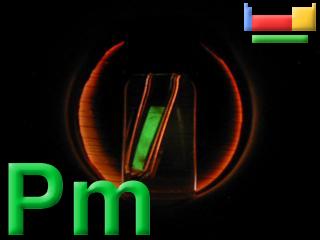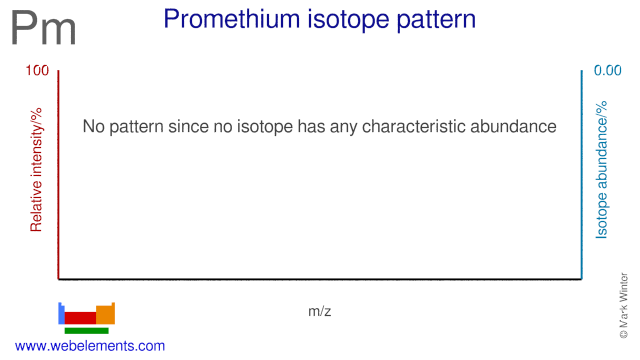Promethium - 61Pm: the essentials
- Name: promethium
- Symbol: Pm
- Atomic number: 61
- Relative atomic mass (Ar): [ 145 ] (longest lived isotope)
- Standard state: solid at 298 K
- Appearance: metallic
- Classification: Metallic
- Group in periodic table:
- Group name: Lanthanoid
- Period in periodic table: 6 (lanthanoid)
- Block in periodic table: f
- Shell structure: 2.8.18.23.8.2
- CAS Registry: 7440-12-2
Promethium atoms have 61 electrons and the shell structure is 2.8.18.23.8.2. The ground state electronic configuration of neutral promethium is [Xe].4f5.6s2 and the term symbol of promethium is 6H5/2.
Promethium: description
Great care is required while handling promethium as a consequence of its radioactivity. Promethium salts luminesce in the dark with a pale blue or greenish glow, due to their high radioactivity. Ion-exchange methods led to the preparation of about 10 g of promethium from atomic reactor fuel processing wastes in early 1963.
Little is yet generally known about the properties of metallic promethium. More than 30 promethium compounds have been prepared. Promethium is a rare earth metal. It appears that there is no known Pm existing in the earth's crust.

This sample is from The Elements Collection, an attractive and safely packaged collection of the 92 naturally occurring elements that is available for sale.
Promethium: physical properties
Density of solid: 7264 kg m-3
Molar volume: 20.23 cm3
Thermal conductivity: 15 W m‑1 K‑1
Promethium: heat properties
Melting point: 1373 [1100 °C (2012 °F)] K
Boiling point: 3273 [3000 °C (5432 °F)] K
Enthalpy of fusion: 20.5 kJ mol-1
Promethium: atom sizes
Atomic radius (empirical): 185 pm
Molecular single bond covalent radius: 173 (coordination number 3) ppm
van der Waals radius: 290 ppm
Promethium: electronegativities
Pauling electronegativity: (no data) (Pauling units)
Allred Rochow electronegativity: 1.07 (Pauling units)
Mulliken-Jaffe electronegativity: (no data)
Promethium: orbital properties
First ionisation energy: 538.10 kJ mol‑1
Second ionisation energy: 1055.4 kJ mol‑1
Third ionisation energy: 2170 kJ mol‑1
Promethium: abundances
Universe: (no data) ppb by weight
Crustal rocks: (no data) ppb by weight
Human: (no data) ppb by weight
Promethium: crystal structure

Promethium: biological data
Human abundance by weight: (no data) ppb by weight
Promethium has no biological role.
Promethium: uses
Promethium: reactions
Reactions of promethium as the element with air, water, halogens, acids, and bases where known.
Promethium: binary compounds
Binary compounds with halogens (known as halides), oxygen (known as oxides), hydrogen (known as hydrides), and other compounds of promethium where known.
Promethium: compound properties
Bond strengths; lattice energies of promethium halides, hydrides, oxides (where known); and reduction potentials where known.
Promethium: history
Promethium was discovered by J. A. Marinsky, Lawrence Glendenin, Charles D. Coryell in 1945 at United States. Origin of name: named after "Prometheus" in Greek mythology, who stole fire from the gods.Promethium: isotopes

Promethium: isolation
Isolation: promethium metal is available commercially so it is not normally necessary to make it in the laboratory, which is just as well as it is difficult to isolate as the pure metal. This is largely because of the way it is found in nature. The lanthanoids are found in nature in a number of minerals. The most important are xenotime, monazite, and bastnaesite. The first two are orthophosphate minerals LnPO4 (Ln deonotes a mixture of all the lanthanoids except promethium which is vanishingly rare) and the third is a fluoride carbonate LnCO3F. Lanthanoids with even atomic numbers are more common. The most comon lanthanoids in these minerals are, in order, cerium, lanthanum, neodymium, and praseodymium. Monazite also contains thorium and ytrrium which makes handling difficult since thorium and its decomposition products are radioactive.
For many purposes it is not particularly necessary to separate the metals, but if separation into individual metals is required, the process is complex. Initially, the metals are extracted as salts from the ores by extraction with sulphuric acid (H2SO4), hydrochloric acid (HCl), and sodium hydroxide (NaOH). Modern purification techniques for these lanthanoid salt mixtures are ingenious and involve selective complexation techniques, solvent extractions, and ion exchange chromatography.
Pure promethium is available through the reduction of PmF3 with calcium metal.
2PmF3 + 3Ca → 2Pm + 3CaF2
This would work for the other calcium halides as well but the product CaF2 is easier to handle under the reaction conditions (heat to 50°C above the melting point of the element in an argon atmosphere). Excess calcium is removed from the reaction mixture under vacuum.
